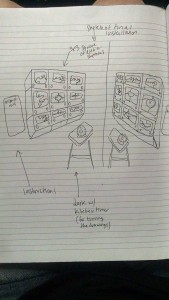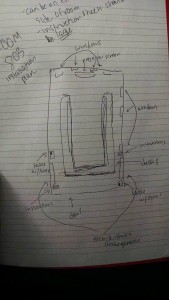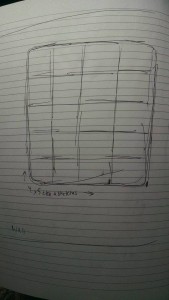WHAT IS THE INSTALLATION?
My installation consists of two arrangements of Etch-a-Sketches on opposite-facing walls. Each arrangement is three toys wide by three toys high, with eighteen Etch-a-Sketches in total. On the wall to the left of each arrangement is a large typed and printed poster baring the following rules:
- 1. Each drawing must connect (at least one line in each piece must “meet” with at least one line in every piece that surrounds it) to each of the drawings surrounding it, via one or more of the lines in the drawing.
- 2. Only one person may work on the piece at any given time.
- 3. You may work on an Etch-a-Sketch that already has work on it, but each screen must have a work on it by the end.
- 4. There is a time limit of five minutes per person per drawing. There is a kitchen timer on the table to your right; please set it to five minutes before you begin drawing.
- 5. You may not work on the arrangement on the opposite wall; however, as mentioned in rule 3, you may work on another Etch-a-Sketch on this wall.
- 6. Your drawing should address the concept of “play”.
To the right of each arrangement is a desk with a kitchen timer on it, which the exhibit-goers will use to time their experiences and make sure they draw only for five minutes at a time.
INTENT OF PROJECT/INSTALLATION
The intent of this project is to create two spaces for the class to make what will at first be a seemingly identical pair of rule-based art pieces. By this I mean that the two sets of instructions placed beside the two Etch-a-Sketch arrangements list the exact same instructions, and could therefore theoretically produce the same exact piece of art. However, given that different people will be working on different Etch-a-Sketch arrangements at different times, it is extremely unlikely that both arrangements will bare the same drawing by the end of the exhibit.
HOW DOES THIS INSTALLATON ADDRESS THE TOPIC OF “TIME”?
The drawing that is finally created on each arrangement of Etch-a-Sketches will be continuously changing over the time of the exhibition, making it an art piece that is largely based in time, as well as participation and interactivity. Given the anticipation of there being more than 18 people who will interact with the piece, it is likely that all of the 18 Etch-a-Sketches will be filled before each person can create part of the drawing on a blank screen. However, rule 3 states that users may draw on an Etch-a-Sketch that already has work on it, so the drawing may continue to evolve as new exhibit-goers pass by the piece; therefore, the final piece will continue to evolve past the initial point of being “finished,” according to the rules.
REFERENCES/INSPIRATIONS FOR THIS INSTALLATION
This installation piece draws greatly upon the idea behind the Conceptualism movement; that the concept of a piece of art is more important than the aesthetic value of the final piece. The artist Sol Lewitt provided a definition of what conceptual art truly is; in his 1967 essay, “Paragraphs on Conceptual Art,” he said “In conceptual art the idea or concept is the most important aspect of the work. When an artist uses a conceptual form of art, it means that all of the planning and decisions are made beforehand and the execution is a perfunctory affair. The idea becomes a machine that makes the art.”
Lewitt worked in the same medium I use for this installation piece: rule based art (note: this is different from what is widely accepted as the definition of “instruction-based art” which uses computers and machines to create pieces of art, using instructions written by the artist). Lewitt would come up with sets of rules that could be interpreted differently, and give them to people to follow and create the work of art; he would often have different people create pieces base don the same instructions, thus creating very different works of art that were based on the exact same set of rules.
In my preliminary phase of coming up with ten very vague topics off of which to base my installation piece, I thought of the way the shorelines of landmasses change over time. I thought specifically of the shores of Cape Cod, a landmass whose own shape looks like it might very well be someone’s strange drawing of an arm done on an Etch-a-Sketch. The shores of Cape Cod are extremely susceptible to damage done by storms that bring huge waves crashing ashore; the sea is steadily dragging more and more of Cape Cod into the Atlantic Ocean each year. This is both a very intriguing source of inspiration for my piece, as well as a reference to something that is important to me (I have been visiting the house my grandparents built on Cape Cod since I was an infant). In my opinion, this is perhaps the most interesting and accurate (the most similar to my piece) source of inspiration; the shape of the shoreline of Cape Cod is always changing over time, with every wave that washes upon the shore. This draws a parallel to the idea of how a drawing will change over time when many different people add features to it and it’s also pretty humbling and unbelievable to see how much the ocean changes the land and how strong of a force the sea is.
RESEARCH
For my project, I did research on the Conceptual Art movement and into artists who worked with interactivity-based artwork or rule-based artwork. I also looked into instruction-based art, which is similar to Sol Lewitt’s rule-based art, though this form does not involve human participants and instead uses computers and other machines as vessels for creating art. Human beings and computers are very different and people often argue whether or not a robot/machine could be created that has “a conscience” and I find it very interesting that between these two extremely similar forms of art, one utilizes human beings and one utilizes machines.
Desmond Paul Henry was an artist who worked with these kinds of “drawing machines.” In the 1960s, during the computer art movement, Henry built three different machines that could create line drawings and, through the use of photochemical techniques, interesting and unusual visual effects. Early in his career, Henry modified bombsight analogue computers, which were used in World War II to determine the release of bombs onto their targets from the fighter planes carrying these weapons. Even though Henry created his work by giving instructions to computers, both his artwork and my final project employ the idea of giving instructions to an external entity in order to create art. Perhaps a more obvious parallel is the fact that Henry used computers to create line drawings, much like an Etch-a-Sketch does, though the designs created by Henry’s computers are much more perfected than anything a human hand could (easily, at least) create with an Etch-a-Sketch.
Another artist whose work my installation could be compared to is Lygia Clark, who made many interactive art pieces which depended on participation from others in order to become “complete.” Clark’s work was much more physical and often involved the use of the viewer or participant’s whole body; at points in her career, Clark practiced these activities with private clients, her art becoming a sort of therapeutic technique. I’m intrigued in the psychology connection between my piece and Clark’s body of work; Clark’s work became intertwined with the psychological states of individual participants, while my installation piece deals more with the psychology of a group of people. It seems unexpected that art installations would have therapeutic benefits, but in reality art therapy is a very common practice, and physical activity is known to have psychological benefits.


